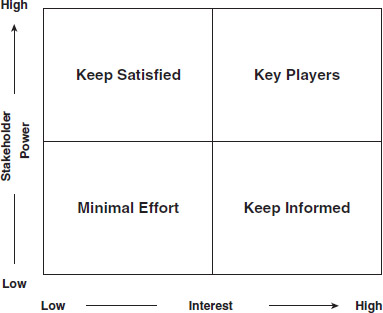Activity 5
Stakeholder management
Overview
First published in 1991, this model looks at understanding the influence that different stakeholders have on category development. It does this by classifying the stakeholders in relation to the power they hold and the extent to which they are likely to show an interest in supporting or opposing the project accordingly.
Elements
Although the power of each stakeholder will vary from industry to industry, market to market and country to country, two key factors will remain the same:
- the interest each stakeholder shows in communicating his or her expectations on the organisation’s category management strategy;
- the levels of power and persuasion the stakeholder possesses to enable this to occur.
The four key elements of the matrix are as follows:
- 1 Low power / low interest – The stakeholders in this group do not require much effort in consultation.
- 2 Low power / high interest – These stakeholders need to be kept informed, but mostly as a matter of courtesy, since they have little power.
- 3 Low interest / high power – These stakeholders need to be kept satisfied because they have high power and they could prove resistant if they were to be upset by category team actions.
- 4 High interest / high power – These are the ‘key players’ who must be consulted and considered at every stage of the category project because their active support is needed to get things done. They are likely to have direct influence on and responsibility for resources that are needed.
So what?
Understanding stakeholders in this way can enable better and more meaningful communication. For example, continually arranging face-to-face meetings with a stakeholder who has little power could be avoided and thus more focus placed on those that are key decision makers.
This model can be extended beyond just category management to be applied to any aspect of supply-chain delivery.
Category management application
- Builds a profile of key business stakeholders in the category management project
- Assists with building cross-functional relationships
- Helps gain support and buy-in to category management decision making
- Identifies areas of potential conflict (organisation vs. stakeholder and stakeholder vs. stakeholder)
Limitations
This matrix provides a simple way of analysing stakeholders; however, once this activity has been performed, it does not aid in understanding how to appropriately communicate with stakeholders. For this, the work of Richard Daft and Robert Lengel (1998) is recommended.
Template
The following template can be used to assess key stakeholders in a category project:
- Template 5: Stakeholder management matrix
